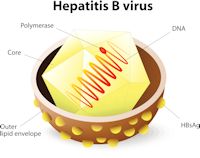Risk of Infection after Occupational Exposure
Hepatitis B Virus (HBV)
Health care workers who have received hepatitis B vaccine and have developed immunity to the virus are at virtually no risk for infection.
For an unvaccinated person, the risk from a single needlestick or a cut exposure to HBV-infected blood ranges from 6%-30% and depends on the hepatitis B e antigen (HBeAg) status of the source individual. Individuals who are both hepatitis B surface antigen (HBsAg) positive and HBeAg positive have more virus in their blood and are more likely to transmit HBV.
Hepatitis C Virus (HCV)
Based on limited studies, the estimated risk for infection after a needlestick or cut exposure to HCV-infected blood is approximately 1.8%. The risk following a blood splash is unknown but is believed to be very small; however, HCV infection from such an exposure has been reported.
Human Immunodeficiency Virus (HIV)
- The average risk for HIV infection after a needlestick or cut exposure to HIV-infected blood is 0.3% (about 1 in 300). Stated another way, 99.7% of needlestick/cut exposures to HIV-contaminated blood do not lead to infection.
- The risk after exposure of the eye, nose, or mouth to HIV-infected blood is estimated to be, on average, 0.1% (1 in 1,000).
- The risk after exposure of the skin to HIV-infected blood is estimated to be less than 0.1%. A small amount of blood on intact skin probably poses no risk at all. There have been no documented cases of HIV transmission due to an exposure involving a small amount of blood on intact skin (a few drops of blood on skin for a short period of time). The risk may be higher if the skin is damaged (for example, by a recent cut), if the contact involves a large area of skin, or if the contact is prolonged.
Protection after Occupational Exposure
Wounds and skin sites that have been in contact with blood or body fluids should be washed with soap and water; mucous membranes should be flushed with water. Immediate evaluation must be performed by a qualified health care professional.
Health care providers who evaluate exposed dental health care professionals should be:
- selected before dental health care professionals are placed at risk of exposure
- experienced in providing antiretroviral therapy
- familiar with the unique nature of dental injuries so they can provide appropriate guidance on the need for antiretroviral prophylaxis
Knowledge Check Choose the best answer for the question.
1-8. Wounds and skin sites that have been in contact with blood or body fluids should be _____.
You forgot to answer the question!

